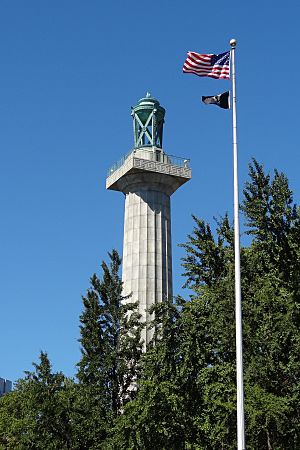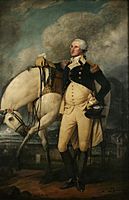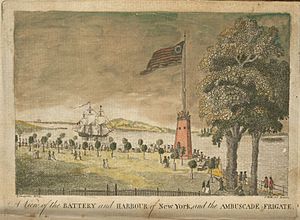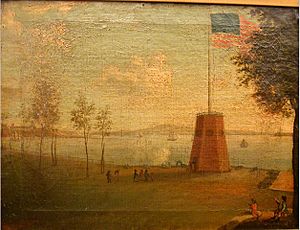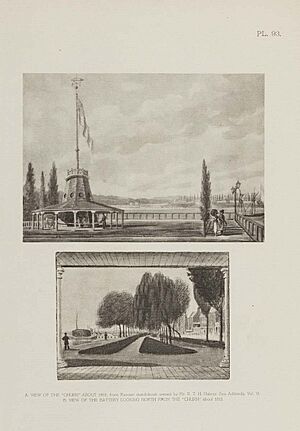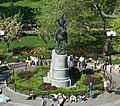Evacuation Day (New York) facts for kids
Evacuation Day for New York was a very special day. It was when the last British soldiers and officials left Manhattan on November 25, 1783. After they left, General George Washington proudly led the Continental Army through the city. This marked the end of the American Revolutionary War in New York.
Contents
New York During the War
After a tough battle called the Battle of Long Island in August 1776, General George Washington and his Continental Army had to retreat. They crossed the East River from Long Island to Manhattan. A thick fog helped them escape safely.
Washington's troops then moved north and west on Manhattan Island. After more fighting, including battles at Harlem Heights and Fort Washington, they left Manhattan. They headed into Westchester County and then across New Jersey.
For most of the Revolutionary War, New York City was under British control. It became the main center for British military operations. Many people who stayed in the city were Loyalists, meaning they supported the British.
The city was also important for American spies. One famous spy was Nathan Hale.
In September 1776, a huge fire destroyed many houses in the city. People had to live in temporary homes made from old ships. Even worse, over 10,000 American soldiers and sailors died on British prison ships in New York waters. These ships were in Wallabout Bay. More Americans died on these ships than in all the battles of the war combined. Today, there is a monument in Fort Greene Park in Brooklyn to remember these brave men.
The British Leave New York
Planning the Evacuation
In August 1783, Sir Guy Carleton, the last British commander in North America, got orders to leave New York. He told the American leaders that he would move out all British soldiers, loyalists, and freed slaves as fast as he could. But he couldn't give an exact date right away. This was because many refugees were still coming into the city.
More than 29,000 Loyalists were eventually moved out of New York City. The British also helped over 3,000 Black Loyalists leave. These were formerly enslaved people who had gained their freedom from the Americans by joining the British side. The British took them to places like Nova Scotia, Florida, the Caribbean, and London. They refused to return them to their former enslavers, even though the Treaty of Paris said they should.
The Final Departure
Carleton set the final evacuation date for November 25, 1783, at noon. After the British left, American troops led by General Henry Knox took control of the city.
General George Washington's entry into the city was delayed for a short time. A British flag was still flying on a flagpole in Battery Park. This was at the southern tip of Manhattan. The British had nailed the flag to the pole and greased the pole to make it hard to climb.
Several men tried to take down the British flag. Finally, a veteran named John Van Arsdale helped. He cut wooden pieces and nailed them to the pole to make steps. He then climbed up, took down the British flag, and put up the Stars and Stripes. He did this just before the last British ships sailed out of sight.
Washington's Triumphant Entry
Seven years after his retreat from Manhattan, General George Washington returned. He and New York Governor George Clinton first took back Fort Washington. This fort was on the northwest side of Manhattan Island.
Then, Washington led the Continental Army in a grand march. They paraded down the main road through the island, onto Broadway, and all the way to the Battery. It was a proud moment for the new nation.
-
Washington's Entry into New York by Currier and Ives
After Evacuation Day
Even after Evacuation Day, some British troops stayed in forts in areas that the Treaty of Paris had given to the United States. These were mostly in the Great Lakes area. Britain kept control of some of these forts until 1794, after the Jay Treaty was signed. Some were held even longer, until 1815, after the War of 1812.
A week after Evacuation Day, on December 4, General Washington said goodbye to his officers. This happened at Fraunces Tavern in New York City. He shook hands with each officer, thanking them.
Washington then traveled south, with people cheering him along the way. On December 23, he arrived in Annapolis, Maryland. The American government, called the Confederation Congress, was meeting there. Washington gave a short speech and formally resigned as commander-in-chief of the army. He then went home to his farm, Mount Vernon, in Virginia.
Celebrating Evacuation Day
Early Celebrations
In 1790, the British Fort George was torn down. A public walking area was built in its place. A special flagpole was put up there with a large flag. This flagpole was later moved and a decorative shelter was added in 1809.
On Evacuation Day in 1790, a group called the Veteran Corps of Artillery of the State of New York was started.
The writer Washington Irving visited the flagpole in 1804. He described it as a "gigantic churn" because of its shape.
In 1811, on Evacuation Day, the new Castle Clinton was opened. Its first gun salute was fired that day.
For over a hundred years, Evacuation Day was celebrated every year. Boys would compete to pull down a British flag from a greased pole in Battery Park. Adults also celebrated with parties and drinks.
225th Anniversary in 2008
Evacuation Day was not celebrated much in the 1900s. But on November 25, 2008, it was celebrated again for its 225th anniversary. Bright searchlights shone from important high points in New Jersey and New York. These searchlights were like the bonfires used during the war to send signals.
The searchlights were lit at seven Revolutionary War sites in New Jersey. These included Beacon Hill in Summit and Washington Rock in Green Brook. Five locations in New York also took part. These included Bear Mountain State Park and Storm King State Park.
Images for kids
-
General George Washington Resigning His Commission, by John Trumbull, 1824
-
Julius Caesar at the Winter Garden Theatre, with John Wilkes Booth, Edwin Booth, and Junius Brutus Booth Jr., November 25, 1864
-
Evacuation Day Parade of First Division under Charles W. Sandford, New York State Militia, 1866
-
Menu from centennial banquet hosted by the Chamber of Commerce of the State of New York at Delmonico's
-
Raising the Stars and Stripes, 1883 print showing a variant of the Cowpens flag and a completely inauthentic Union Jack
-
Monument in Bennett Park marking the November 16, 1776, evacuation and the November 25, 1783 triumphal entry of the American forces
-
Henry Kirke Brown's George Washington in Union Square commemorates Washington's entrance to the city on Evacuation Day
-
A view of the second Battery Flagstaff about 1812, with surrounding gazebo


